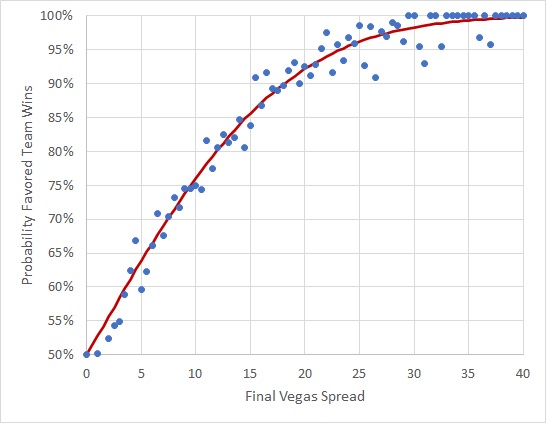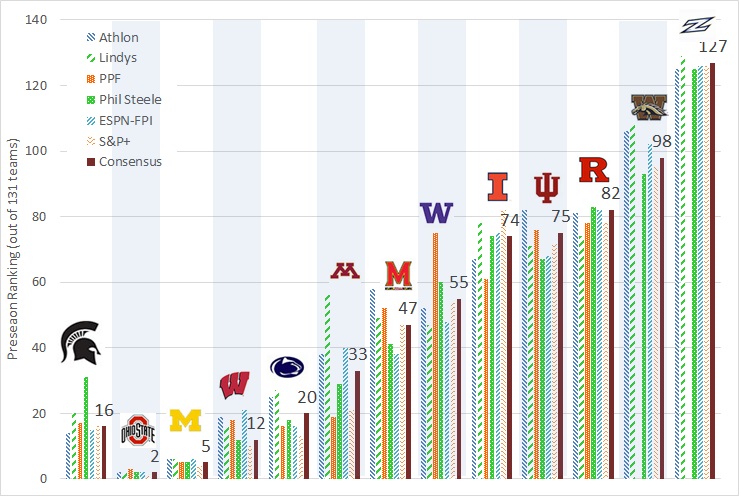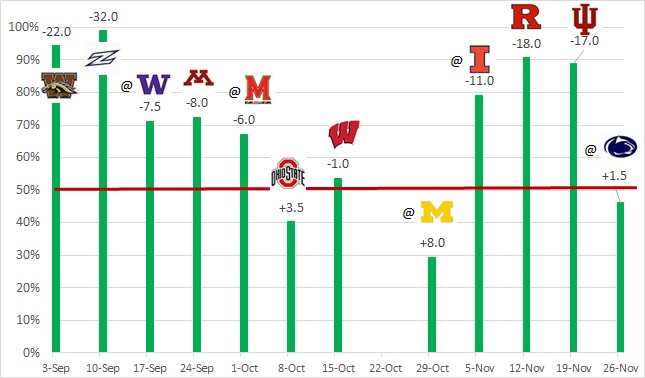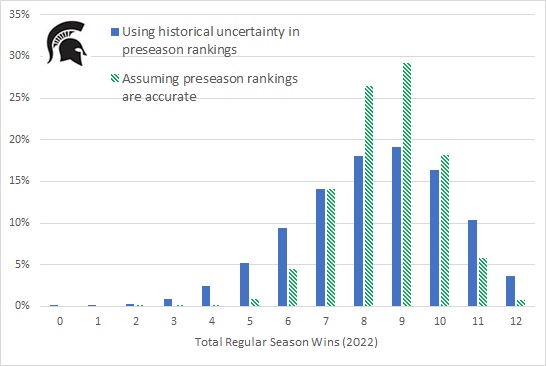The calendar says that it is summer time, but the 2022-23 college football season is right around the corner. For over 20 years, I have been refining various mathematical tools that I use to understand and project the trajectory of the college football season. I have once again run the numbers for the upcoming season and I am ready to start sharing the results, starting with an overview of the Michigan State Spartans.
Before digging into the number for the Green and White, I would like to provide a brief overview of my methodology and to set the table for the analysis to come over the next several weeks.
Methodology Overview
The core concept behind my analysis is that the odds that any team will win or lose a football game is defined very accurately by the point spread. That correlation is shown below in Figure 1. Essentially the point spread accurately predicts the final margin of victory of the favored team on average, but with a high standard deviation of 14 points.
Point spread data is very predictive, but it is only available for a specific game a few days before kickoff. Therefore, a system is needed that can predict the point spread for any arbitrary football match-up and venue. Fortunately, over the years I have developed just such as system using only final score and location data as the inputs.
With this system in place, one only needs the schedule information for all 131 FBS teams and then it is possible to perform calculations on strengths of schedule and the odds for teams to win any number of games. More advanced simulations can generate season odds such as the odds for a team their division, conference, make the College Football Playoffs (using some assumptions) and to win the National Title.
My methodology works quite well by itself once the season starts and each team has played a few games. However, at or near the beginning of the season, it is necessary to use some preseason estimates as to the strength of each team to anchor the data. For this input, I use an average of the full FBS preseason rankings from as many sources as I can find. This year, I pulled data from ESPN's FPI, S&P+, Lindys, Athlon, Phil Steele, and Pro Football Focus. As the season progresses, the influence of these preseason rankings are steadily reduced and finally elimiated from the calculations.
All of the analyses that I have mentioned so far can often be found in other places. However, my method has one unique feature that makes it far more accurate than the odds and numbers generated by systems such as ESPN's FPI. My method explicitely considers the uncertainty in the preseason rankings themselves. The historical data suggests that preseaon rankings are only accurate within about 20 slots in either direction. When this known uncertainty in included in the full season simlation, much more accurate statistics can be generated.
Just as a practical example, last year Michigan State was only projected to win about four games based on the preseason rankings, which varied from No. 51 to No. 87 in various publications. When all of the other sources calculated the probability for the Spartans to win 10 or more games, the odds worked out to roughly one-in-30,000. If this were correct, Michigan State's actual 2021 season would have been so rare that it would have been expected to happen only once in over 200 seasons!
However, if the known uncertainty of the preseason rankings were considered, the odds of the 2021 Spartans winning 10 or more games rose to aournd one-in-95. While this is still pretty rare, it is on the order of something that would happen to one or two teams every year, which is much more reasonable.
The methods outlined above does a good job of generating accurate odds for the full season, but at the end of the day there is only one scenario that will actually occur in reality. To this end, part of my process is to project the final records of each team using two different strategies.
In my base case, I simply project the final records based on the scenario where the projected favorite team wins every single game. This is technically the single most likely scenarion (out of an astromonicaly large number of scenarios) but it is still not that likely.
I also perform what I call a "disruptive" simulation where I artifically introduce a historically reasonable number of upsets (about 25 percent of games) with an enphasis on home underdogs. Comparing the results of my base and disruptive simulation provides some insight as to which games might have the most impact on the overall college football season.
Michigan State Season Overview
With that primer in hand, let us know turn on focus onto the 2022-23 Michigan State Spartan football season, starting with the Green and White's ranking and schedule. Figure 2 below summarizes Michigan State preseson rankings in all of the sources that I used this year as well as the preseason rankings for all 12 of the Spartans' opponents, from strongest to weakest.
Figure 2 is a bit of an eye chart, but it does give some initial perspective on the Spartans' 2022 schedule. First of all, Michigan State's preseaon ranking is fairly consistent, with five of the six sources placing the Green and White somewhere between No. 14 and No. 20 overall. The lone exception is Phil Steele, who ranks Michigan State at No. 31.
Steele has some legitimate claims on being the most accurate college football prognosticator, but I will note that he also had the Spartans ranked below all of the other publications last year as well. In retroscpect, this means that he was the most wrong in 2021.
As for Michigan State opponents, only Ohio State (consensus rank No. 2) and Michigan (No. 5) are clearly ranked ahead of the Spartans. After that, Wisconsin (No. 12) and Penn State (No. 20) are ranked similarly to Michigan State. The different preseaon rankings have varying opinions as to the strength of those three teams and thus the averages put the Spartans right in the middle.
The preseason rankings for Minnesota are even more erratic. Most of sources have Michigan State clearly ahead of the Gophers. But Pro Football Focus has the Spartans just two slots ahead of the Gophers, and Phil Steele has Minnesota a two slots ahead of Michigan State.
As we continue moving left to right across the schedule, Maryland (No. 47) and Washington (No. 55) project as the next two toughest opponents, and there is a bit more consensus as to the strength of these teams. No source has Maryland ranked better than No. 38 and no source has the Huskies higher than No. 48.
The Spartans next three opponents, Illinois (No. 74), Indiana (No. 75) and Rutgers (No. 82) are all ranked similarly, with Western Michigan (No. 98) a half step back from this trio. Bringing up the rear this year is Akron (No. 127 of 131) who is picked to finished last in the MAC East.
With the data from Figure 2 as an input, along with Michigan State's schedule and the historical uncertainty in every teams' ranking, I simulated the Spartans' season 250,000 times. The results of this simulation provided a projection of the odds for Michigan State to win each of the 12 games on the schedule. Using Figure 1, these probabilites can be converted into projected point spreads. These data are summarized below in Figure 3.
From Figure 3, it is possible to gain a better understanding of the way Michigan State's season is likely to play out. I will note here that this year I rank Michigan State's overall schedule as the No. 25 most difficult in the FBS (good for sixth place in the Big Ten). The Spartans conference-only schedule is ranked fifth in the Big Ten. I will delve deeper into stregnth of schedule data in the next installment of this series.
As expected, the Spartans are projected to be huge favorites in their first two home games against MAC opponents Western Michigan and Akron. The three games after that (at Washington, versus Minnesota, and at Maryland) all project to have Michigan State favored by roughly a touchdown.
While that sounds very positive, the math suggests that the Spartans will most like go 4-1 in that opening stretch, even if we assume that Michigan State is truly a top 20 caliber team. A 4-1 start will not be the end of the world. In contrast, if the Spartans can go 5-0 to open the season, it will be a very good sign.
Following the road game at Maryland, Michigan State enters a mid-season gauntlet where they will play Ohio State, Wisconsin, and at Michigan over a four week period. The Spartans project to be underdogs against the Buckeyes and Wolverines, and the game with the Badgers looks like a toss-up.
The math for this three-game stretch suggests that the Spartans will most likely go 1-2. Obviously, the home game versus Wisconsin is the most likely win, but the Ohio State game is also at home, and Michigan State always plays the Woverines tough, no matter the venue. A record of 2-1 in this stretch is not outlandish, nor is a record of 0-3.
Following the game versus Michigan, the Spartans draw three games that all look quite winnable: at illinois and home games against Indiana and Rutgers. Michigan State currently projects to be a double-digit favorite in all three games, but the odds of winning all three games is only around 65 percent.
Michigan State closes out the regular season with a near toss-up contest at Penn State. When the final four games of the season are considered together, MSU is most likely to finish 3-1 in the home stretch. Obviously the Penn State game is the most likely loss, but it is was very reasonable that the Green and White could pick off the Nittany Lions but stub their toe in Champaign (for example).
In total, the analysis above leads to the conclusion that Michigan State will most likely finish the regular season with a record of 8-4. However, the results of the full-season simulation provide a more accurate accont of the Spartans' possible win distribution. Figure 4 below shows the results of these simulations.
Figure 4 compares two different sets of data, both of which try to answer the same question: how many games will Michigan State win in 2022? The blue and white striped bars give the results of a calculation which assumes that the preseason rankings are correct. This is essentially the same data that every other website will provide. But, these numbers are not accurate.
The solid green bars reprent the results of my similation of the full season with the known uncertainty of the preseason rankings taken into account. As I have shown previously, this analysis does give accurate results. The overall shape and position of both distributions is essentially the same, but the more accurate green distribution is more broad.
This more precise analysis reveals that the expected win total for the Spartans is 8.32. Interestingly, the math suggests that a nine-win season is the most likely single outcome. The data also suggests that there is a 50-50 chance that Michigan State finishes with between eight and 10 wins total.
My analysis give the Spartans a 3.6 percent chance to run the table at 12 wins. On the other hand, the math also says that there is an 8.9 percent chance that Michigan State fails to win five games and stays home for the holidays. In these two extreme cases, the Spartans are either quite a bit better or quite a bit worse than the preseason rankings suggest.
While Figure 4 gives an accurate picture of overall season odds for the Green and White, Figure 3 also suggests that the Spartans will be favored in nine of their 12 total games. This simple analysis agrees with the Figure 4 in that the most likely single outcome is for Michigan State to finish at 9-3.
That said, in my disruptive simulation of the season, the Spartans edge the Buckeyes at home and finish the season at 10-2. As we will see in the next installment of this series, this potential upset could have major implications in the overall Big Ten race.
As for other season odds for the Spartans, my simulation gives Michigan State a 13.2 percent chance to win the Big Ten East, an 8.2 percent chance to win the Big Ten title, a similar 8.1 percent chance to make the College Football Playoff, and a 1.8 percent chance to win the National Title.
How to these number compare to the rest of the Big Ten? That will be the subject of Part Two of this six-part math-based preview. Stay tuned. Enjoy, and as always, Go Green.




Comments
Post a Comment